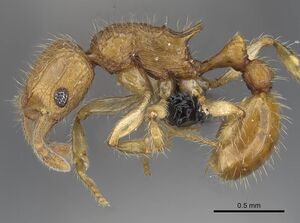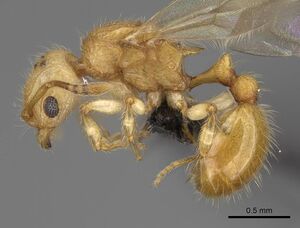Vitsika acclivitas
| Vitsika acclivitas | |
|---|---|

| |
| Scientific classification | |
| Kingdom: | Animalia |
| Phylum: | Arthropoda |
| Class: | Insecta |
| Order: | Hymenoptera |
| Family: | Formicidae |
| Subfamily: | Myrmicinae |
| Tribe: | Crematogastrini |
| Genus: | Vitsika |
| Species: | V. acclivitas |
| Binomial name | |
| Vitsika acclivitas Bolton & Fisher, 2014 | |
Almost all the specimens were from leaf litter samples in tropical dry forest. Only the two queens that constitute the NE Andapa sample were from rainforest.
Identification
Bolton and Fisher (2014) - Among the small, yellow species of Vitsika, acclivitas is distinguished by its much less erect petiole node. The node shape that seems most similar is that of Vitsika venustas, but in that species the anterior face of the petiole node is not as shallowly inclined, and the postpetiole in profile has a node that is visibly longer than the height of the segment.
Keys including this Species
Distribution
Endemic to Madagascar.
Latitudinal Distribution Pattern
Latitudinal Range: -13.16666667° to -13.16666667°.
| North Temperate |
North Subtropical |
Tropical | South Subtropical |
South Temperate |
- Source: AntMaps
Distribution based on Regional Taxon Lists
Malagasy Region: Madagascar (type locality).
Distribution based on AntMaps
Distribution based on AntWeb specimens
Check data from AntWeb
Countries Occupied
| Number of countries occupied by this species based on AntWiki Regional Taxon Lists. In general, fewer countries occupied indicates a narrower range, while more countries indicates a more widespread species. |

|
Estimated Abundance
| Relative abundance based on number of AntMaps records per species (this species within the purple bar). Fewer records (to the left) indicates a less abundant/encountered species while more records (to the right) indicates more abundant/encountered species. |

|
Biology
Castes
Males have yet to be collected.
Images from AntWeb
   
| |
| Holotype of Vitsika acclivitas. Worker. Specimen code casent0044902. Photographer Michele Esposito, uploaded by California Academy of Sciences. | Owned by CAS, San Francisco, CA, USA. |
    
| |
| Queen (alate/dealate). Specimen code casent0054091. Photographer Michele Esposito, uploaded by California Academy of Sciences. | Owned by CAS, San Francisco, CA, USA. |
Nomenclature
The following information is derived from Barry Bolton's Online Catalogue of the Ants of the World.
- acclivitas. Vitsika acclivitas Bolton & Fisher, 2014: 73, figs. 81-83, Map 149 (w.q.) MADAGASCAR.
Unless otherwise noted the text for the remainder of this section is reported from the publication that includes the original description.
Description
Worker
(holotype in parentheses). TL 2.5–3.0 (2.7), HL 0.56–0.66 (0.61), HW 0.48–0.55 (0.53), CI 83–87 (87), SL 0.38–0.46 (0.42), SI 80–85 (80), PW 0.35–0.45 (0.40), WL 0.66–0.80 (0.77) (10 measured).
Eye with 6 rows of ommatidia, and with 7–8 ommatidia in the longest row; EL 0.13–0.16 (EL/HW 0.26–0.29). MfL 0.44–0.56 (MfL/HW 0.96–1.01). Propodeal spiracle relatively small, diameter of annulus of propodeal spiracle is usually slightly less than the thickness of the propodeal spine at its midlength. Petiole node large, tall and characteristically shaped: in profile the dorsal surface of the peduncle is continuous with the anterior face of the node, the two run together through a very obtuse angle, so that the anterior face of the node slopes upwards and posteriorly only shallowly relative to the dorsum of the peduncle. The anterior face of the petiole node rises to the short, narrowly rounded dorsum, and the posterior face has about the same degree of slope as the anterior. Height of petiole node in posterior view (from midpoint of the dorsal margin of the foramen to the apex) 0.82–0.89 × its maximum width. In dorsal view postpetiole 1.10–1.18 × broader than long; maximum width of postpetiole 1.15–1.36 × the length of a propodeal spine; maximum width of postpetiole 0.90–1.00 × the distance between the apices of the propodeal spines. Length of postpetiole node in profile about equal to the height of the segment. Disc of postpetiole usually with some weak punctulate sculpture, especially on the posterior half. Full adult colour yellow.
Queen
(gyne). Only alates known; may be polygynous as several queens appears in one series. HL 0.65–0.70, HW 0.56–0.60, CI 86–88, SL 0.44–0.47, SI 77–79, PW 0.52–0.56, WL 0.90–0.98, maximum width of mesoscutum 0.50–054, maximum length of mesoscutum 0.48–0.53, MfL 0.56–0.60 (MfL/HW 0.85–1.00) (3 measured). With three distinct ocelli, a full complement of flight sclerites and a conspicuous sulcus across the mesopleuron. The shape of the petiole node parallels that seen in the worker.
Type Material
Holotype worker, Madagascar: Prov. Antsiranana, Forêt Bekaraoka, 6.8 km. 60° ENE Daraina, 7–9.xii.2003, 13°10.0’S, 49°42.6’E, sifted litter, tropical dry forest, BLF 9872(22), CASENT0044902 (Fisher et al.) (California Academy of Sciences). Paratypes. 1 worker and 1 dealate queen, with same data as holotype and all BLF 9872: worker, (2) CASENT0044917; queen, (2) CASENT0044916 (CASC).
References
- Bolton, B. & Fisher, B.L. 2014. The Madagascan endemic myrmicine ants related to Eutetramorium (Hymenoptera: Formicidae): taxonomy of the genera Eutetramorium Emery, Malagidris nom. n., Myrmisaraka gen. n., Royidris gen. n., and Vitsika gen. n. Zootaxa 3791:1–99. doi:10.11646/zootaxa.3791.1.1
References based on Global Ant Biodiversity Informatics
- Bolton B., and B. L. Fisher. 2014. The Madagascan endemic myrmicine ants related to Eutetramorium (Hymenoptera: Formicidae): taxonomy of the genera Eutetramorium Emery, Malagidris nom. n., Myrmisaraka gen. n., Royidris gen. n., and Vitsika gen. n. Zootaxa 3791(1): 1-99.

